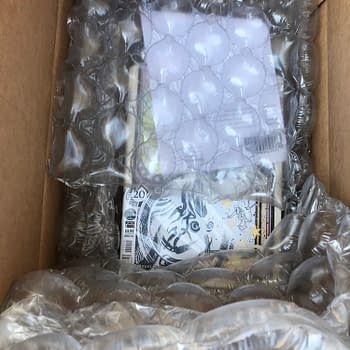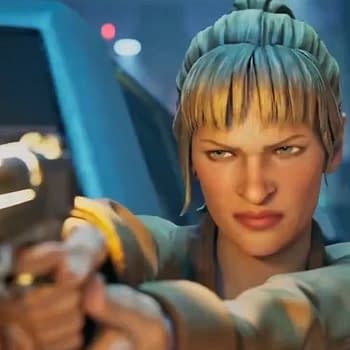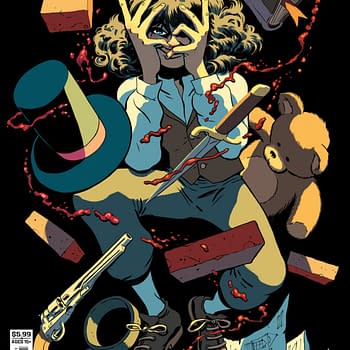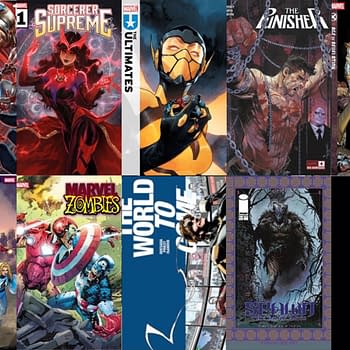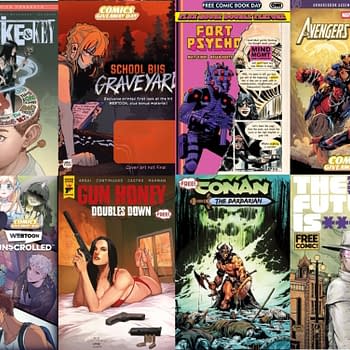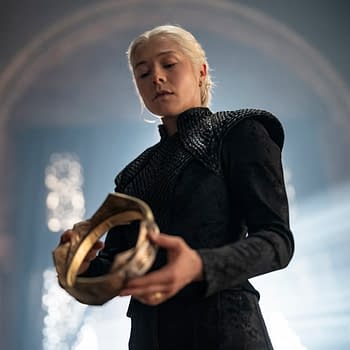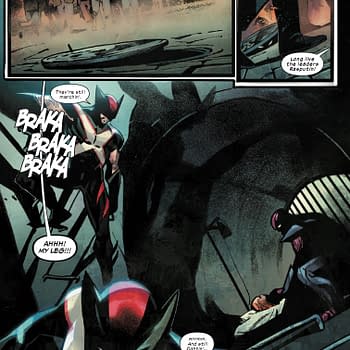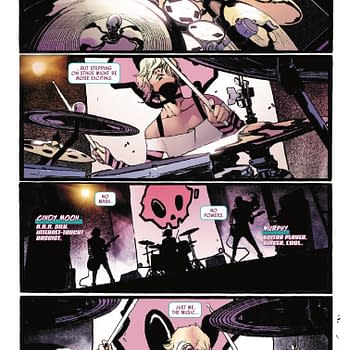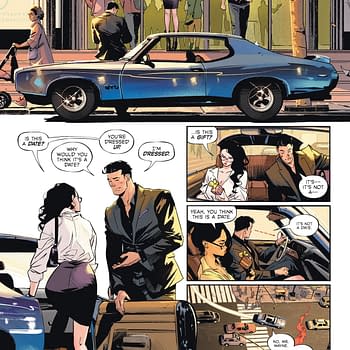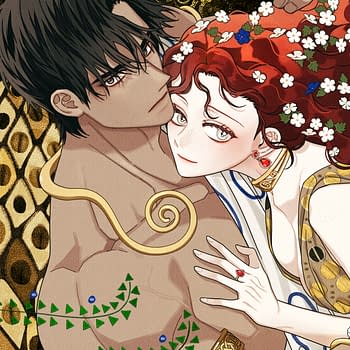Posted in: Comics | Tagged: Andrew Carl, Chris Stevens, cliff chiang, Comics, David Mack, dean haspiel, Denis Kitchen, entertainment, Farel Dalrymple, J.G. Jones, john cassaday, Josh O'Neill, kickstarter, Little Nemo, Little Nemo: Dream Another Dream, Locust Moon Comics, Matt Huynh, Mike Sgier, Paul Pope Bill Sienkiewwicz, Raul Gonzales, Slumberland, winsor mccay
Bleeding Cool and Locust Moon Comics Talk Little Nemo: Dream Another Dream
By Nikolai Fomich
Locust Moon Comics proudly announced their Little Nemo: Dream Another Dream Kickstarter campaign earlier this week. I sat down with two of the minds behind the project – Publisher Josh O'Neill and Creative Director Chris Stevens – to talk about McCay's visionary work and Dream Another Dream. Together with Locust Moon's Editor-in-Chief Andrew Carl, Josh and Chris have gathered the greatest talents working in comics today to produce a truly extraordinary anthology.
Josh O'Neill Holding James Harvey's Page
Nikolai Fomich: Who was Winsor McCay, and what role did he play in the development of American comic art?
Josh O'Neill: Winsor McCay was one of the forefathers of American cartooning and animation. He did newspaper strips, cartoons, editorials, and is one of the true founders of modern cartooning language. And, arguably, the inventor of animation.
NF: For those who might be unfamiliar with McCay's work, talk a bit about Little Nemo in Slumberland, and what made that comic strip so unique and important.
Chris Stevens: Formally, his use of composition and Art Nouveau style. He brought storytelling techniques that had never been seen in comics before. Nemo itself is a strip that's filled with constant wonder.
JO: It's the combination of perfect classical training and illustration techniques mixed with an unbelievable creativity, this insane, dreamlike vision of 'anything is possible'. Newspaper pages used to be a lot bigger than they are now, and he took full advantage of every inch of that, of that gigantic space, and invented each page as its own creation.
NF: What is Little Nemo: Dream Another Dream?
CS: Little Nemo: Dream Another Dream is our tribute to the original work. We wanted to gather our favorite creators, and have them run free in McCay's Slumberland world. So it ultimately is a collection of some of the greatest cartoonists living today, paying tribute to him by putting their own spin on his concept.
Winsor McCay's Little Nemo in Slumberland
NF: What drew you to the original material? What were the origins of this project?
CS: We had finished Once Upon a Time Machine, and we were kicking around ideas for some other things. Josh was the one who said, "What if we did a Little Nemo book? And what if we did it like the Sunday Press books that we love so much, and tried to get our favorite people?" We were pretty confident we could get Farel Dalrymple and J.G. Jones – we knew those guys would do it, so we had a good start right there. It snowballed into this incredible thing over the next two years, where we wound up with 140 of some the best creators out there, from the biggest names in the field, like Bill Sienkiewicz and Paul Pope, down to people Josh discovered, or I discovered, or people who pitched us, or came to store, asking if they could be part of it. It became this huge undertaking.
JO: Little Nemo is my favorite comic, and Peter Maresca's Sunday Press Little Nemo editions are, bar none, my favorite books in the world. They're desert island books for me, and not just because they're big enough to use as a liferaft. They inspire me, intimidate me, and make me want to create and tell stories – and I'm far from the only one who feels that way. We were just so enamored by the idea of all of these voices raised in a love song for Winsor McCay, seeing his incredible influence filtered through this endless kaleidoscope of uniquely brilliant talents and visions. We figured we could pay true-blue tribute while doing our damnedest to create something that's worthy of sitting next to those glorious Nemo editions.
NF: How does Dream Another Dream relate to the original work?
JO: The idea wasn't to imitate McCay, or try to do what he did, because there would be no point in that and it probably wouldn't be possible. The idea was to look at this incredible innovator, look at all this unbelievable material he developed, and work in his world. To sing his song in your voice. It's Mount Rushmore stuff, stuff that's hard to live up to, and people who we felt very intimated to work with, felt very intimated by Winsor McCay. It brought out the best out of them, because a half-assed McCay tribute would not be a McCay tribute. What would it be?
This project was a way to get a lot of the greatest creators in comics to do the best work of their careers. Flipping through those pages is amazing. You see people who are young cartoonists, who have just self-published their own books, and haven't had a lot of mainstream success or made a lot of money yet, and you see people who are at the very tip top of the industry, selling millions of copies of books. But you see each of them trying to find a new gear, dig deep into whatever wellspring their inspiration comes from, to do something beyond what they would normally consider themselves capable of. It's been inspiring. And it's something that comes out of love and respect and admiration, to try and honor this person.
NF: And how have you personally grown as a publisher working on this project?
JO: It's been a dizzying experience. We've only been doing this for a few years. We just tried to serve the book above anything else, above anybody's ego, or anybody's stardom. The book just started to turn out to be so good, that any other concerns became secondary, because this book is a once in the lifetime opportunity. It has to be the only thing that matters. That to me was a huge learning experience, and as a publisher that's something I hope to carry with me. You have to serve the book, and everything else has to be subordinate to that.
From Raul Gonzalez's Little Nemo – Dream Another Dream Strip
NF: Looking at the lineup of talent involved, it's clear Locust Moon Press has not only gathered so many of the greatest cartoonists working in North America today, but also artists who are extraordinarily diverse in their storytelling and creative sensibilities – people like Paul Pope, P. Craig Russell, Mike Allred, Bill Sienkiewicz, and J. H. Williams III, just to name a few. I know it must be like picking your favorite child, but can you describe some of the pages that have you most excited?
JO: Oh God, there are just so many. It's every page of the book. David Mack, Farel Dalrymple, John Cassaday. There are certain pages where you're just stunned, where you're taken aback when you see them for the first time.
CS: I would like to get Raul Gonzalez's name in there, because he deserves it.
JO: His was one of the best stories. For most of his career he's been more of a fine artist than a cartoonist. I think he's moving more into cartooning now.
CS: He's a perfect example of the meritocracy of the system, because he has no name in comics, we never saw his comics, and he reached out to us on Facebook, having heard about the project and wanting to take a shot at it. And to be honest, we were really busy at the time, and were getting hit up by a lot of people about a lot of things, and I wasn't rude to him, but I didn't really engage with him. I said, "Here are the specs, good luck." And a couple of weeks later he sent what turned out to be one of all of our favorite pagers. It's like Josh would say, "Who did work that fit the book?" As editors of the book – though our partner Andrew Carl fills the classic role of editor more than me and Josh – we all [kept that in mind].
NF: And it's not just that they're some of the best artists, but also that they're so extraordinarily diverse.
CS: That's another thing we wanted. We all lean towards our favorite styles – Andrew probably has his favorite style, Josh might have his, I might have mine. The key was to combine that into as wide a range as possible, to go from minimalist abstract stuff like Matt Huynh's, to super cartoony lighthearted stuff like Mike Sgier's, to an intense, very poetic strip like David Mack's four pages, back to something a little more like Denis Kitchen. Denis Kitchen turned in one of my favorites. It's very Denis Kitchen, but it's also very Seuss-ian – with such a Doctor Seuss feel. We wanted as wide a range as possible.
JO: I think you need 140 different styles to effectively pay tribute to someone who invented that much of the medium, and didn't invent only one tone. [When people think of Little Nemo]they think of these incredibly well-rendered, gorgeous, and sometimes hallucinatory illustrations. But he was also constantly breaking the fourth wall, playing these clever little formal games, and he was just so far ahead of his time and inventing so many things on the fly, things that nobody had done in comic strips before. It's part of the glory of comics, just how many different things you can do on the page, a space of limitless possibility, and when the page is this size and you're paying tribute to somebody that was that inventive, it takes that idea to its furthest extent.
From Denis Kitchen's Little Nemo – Dream Another Dream Strip
NF: Dream Another Dream seems like the perfect kind of project for comic book artists to express not only their respect for McCay, but also to showcase their storytelling and design skills. What kinds of unique artistic opportunities has this project afforded the artists involved?
CS: Certainly the scale. Not many projects have ever really been published at 16 x 21. So for every creator that I talked to, the scale was definitely a turn on, and what they can do with that. Also, most of these people have a real love for Winsor McCay themselves, and so it was daunting for them, but a turn on too, because it's a challenge. I'm close with Farel Dalrymple, so I know for a fact it was a painful process to get his pages done, because it's Winsor McCay. Winsor McCay could be all four faces on the comics Mount Rushmore. But when Farel was done, he had something he's going to be proud of for a long time. I think a lot of creators approached it that way. I know talking to David Mack and Bill Sienkiewicz, that's how they approached it.
JO: We're a very small company that hasn't been doing this for that long, yet we were able to work with all these amazing people who normally get paid a lot of money. And the amount of artists who thanked us afterward was stunning. They were just so proud that they had something they didn't have before.
CS: When we pitched this to Bill Sienkiewicz he told us he's been waiting thirty years for someone to this.
JO: We're lucky enough to work in this industry which is driven by so many of these incredibly passionate people who care so deeply about the work that they do. And that's what allowed this project to happen.
From David Mack's Little Nemo – Dream Another Dream Strip
NF: I know you guys already touched upon this, but when conceiving of this anthology, how important was it to you that the book be printed in the same broadsheet page size as the McCay originals, and why?
CS: Extremely important.
JO: Yeah, especially when you're signing creators on. Every time I talked to a new person, the two points I would also touch on were that it's a tribute to Winsor McCay and its going to be printed on 16 x 21 full broadsheet newspaper size. Those two facts seemed so united in my mind – that's what the project is, taking the biggest creator back to that space that he inhabited, both physically and metaphorically. The physical [page size] and the metaphorical hugeness of McCay's influence. It's this vanished thing. Cartoonists working on that page size doesn't happen anymore, and to bring that back is pretty amazing, and this is the right project to do it with.
NF: It seems to me that McCay's Little Nemo in Slumberland had already zeroed in on what would become the bread and butter of American comics – the fantasy dreams of young boys. Yet unlike the superhero comic books of the '30's and '40's, fantasy elements don't necessarily empower the young protagonist in Little Nemo – and in fact often threaten him. What is the appeal of Little Nemo and the world of Slumberland, and why do we in continue revisit McCay's strip and its ideas in comics and animation?
CS: I think at the heart of it, [the Little Nemo strips] are as innocent and pure as a little boy's heart, so it's timeless. The world in 1905 couldn't be more different than it is today, but I think a little boy reading Little Nemo, or a little girl reading Little Nemo, is going to get the same feeling out of it that a little kid did back then, and it might be the same for an adult. I guess the appeal for me was always the pure wonder. Nothing's ever had for me the pure wonder of Little Nemo, nothing's ever topped it. Josh said it might be his favorite comic of all time, it might be mine, I'm not exactly sure, but it's definitely the book that gives me the most endless stream of wonder. I get the same thrill out of it as I did when I discovered it 15 years ago, and I'll get the same thrill out of it 20 years from now.
JO: I agree with everything Chris said, and I also agree with what was in your question. The way superhero comics are sort of fantasies, Little Nemo [isn't]. It is in a fantastical world, but it's not really a fantasy. They're mostly nightmares. He always wakes up freaked out, and to me that's part of what makes Nemo comics so interesting and appealing. There's this constant tension, between wonder and beauty, but also a fear, of trying to hang on, and of things always falling apart. To me the standard Nemo strip is one where he falls asleep and finds himself in some world of intricate beauty – and then it collapses all around him. There's a million different stories told in Little Nemo, but that is I think the most recurring motif, collapse. Trying to keep everything together. You're trying to walk across a bridge and it's falling apart, you're trying to climb a tree and the tree is falling apart.
CS: It's not much of a stretch to think McCay probably felt that way in his own life. He's got to keep it together, he's got to pay his bills, he wants to be famous, he wants to make his cartoons.
JO: And he's got this vision of beauty in [his] mind. And it just seems so perfect and beautiful, but there's the endless challenge of trying to hold on to it, and the fear that comes with that. To me, that's the tension. Even though there's not a lot of nightmarish content in Little Nemo, not a lot of scary monsters, there's something at its heart that I think is pretty scary – and very human.
From Paul Pope's Little Nemo – Dream Another Dream Strip
NF: Finally, what can Kickstarter backers of this project expect from Little Nemo: Dream Another Dream?
JO: The truest joy of putting this project together was building a community of people who love something so passionately. It's the joy of sending amazing artists strips from other amazing artists. When you get a strip from one person and say, "I bet Paul Pope would dig this," or, "I bet Denis Kitchen would like this one," sending it to them, and hearing their responses to it. It feels like you're really building this society of McCay lovers, like a sort of brotherhood and sisterhood.
And what this Kickstarter is really about is expanding that beyond just comic creators. It's about taking people who love this one beautiful thing and putting them all together, and making a community out of them. More than pledges and money, the idea of more people joining this incredibly beautiful crusade is very exciting. So for people who support the Kickstarter, we're going to have a lot of exclusive content, a lot of behind the scenes stuff about the book, including videos of artists talking about their strips and an exclusive print set, both only available to Kickstarter backers. But ultimately the most exciting part about the Kickstarter is widening this Little Nemo family we've built.
CS: And the book itself that people will be getting– I think it's safe to say that there's never been a collection of artists like this in one book, so that's what you're getting. There might never be a project like this again. Jae Lee has said to me he's never seen a line up like this and that it's incredible. J.G. Jones has said that. Artist after artist has been blown away by the lineup, so I think the average person who hasn't seen [the art] or has only seen a couple pages online is going to be blown away by the shear breadth of Little Nemo: Dream Another Dream.
JO: It's the best of the best working at the top of their game.
Support the Little Nemo: Dream Another Dream Kickstarter campaign here. Thanks to Josh, Chris, Andrew, and all of the incredible contributing artists for creating something for the ages.
From J. G. Jones' Little Nemo – Dream Another Dream Strip
From Dean Haspiel's Little Nemo – Dream Another Dream Strip
From Cliff Chiang's Little Nemo – Dream Another Dream Strip















